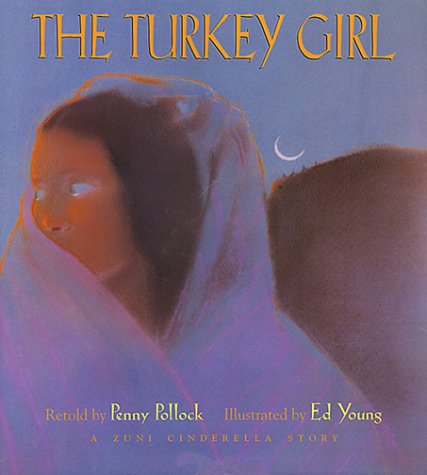
Retold by Penny Pollock
Illustrated by Ed Young
Little, Brown & Co.
Boston, 1996
Ages 9-12
* a young girl living among her people, but alone and unaccepted
* a special dance coming up that the girl would like to attend, but she doesn't have the right clothes
* a magical character who was able to make the girl's dreams of going to the
dance come true, including providing her with beautiful clothes
* a time limitation for when the magic ended
Difference between the two stories include:
* an early North American setting in a southwest pueblo village versus a
setting in a European community replete with castles and royalty
* in this story the girl lives alone; the tribe takes the place of her step family
* her job is to herd the village turkeys for everyone, not do household chores
* instead of a fairy godmother, this story has a big gobbler that does all the
speaking, and along with the rest of the turkeys, help her dream of going to the dance come true by cleaning her up, robing her with a beautiful white doeskin dress, and raining down jewelry on her to wear
* the deadline time in the Cinderella story was marked by a clock and chimes; the deadline time in this story was marked by the sun, referred to as Sun-Father
* there was no shoe/moccasin left for an interested brave to find, and later
use to find her
* the girl shows a self-centered side that costs her companionship of the
turkeys, and also her livelihood.
* unlike the original Cinderella and the many variants that followed, this story had no happily ever after; the Turkey Girl ended up worse off than before
I found another Cinderella variant, Joe Cinders [by Marianne Mitchell and illustrated by Bryan Langdo], which was unusual in that the main character was a boy instead of a girl. But I chose The Turkey Girl to review because it had even more contrasts than the original, and it surprised me that it did not end happily ever after.
Pollock's wording throughout the story reflects a Native American tone and mood. I didn't see any contractions throughout the story; each word, and therefore each sentence is full and poetic. The words are very descriptive and paint pictures themselves. For example:
Each dawn, as Sun-Father began his long journey across the sky, the Turkey Girl, clad in her tattered dress, threadbare shawl, and yucca-cactus sandals, led the turkeys from Matsaki.
or:
Tears streaked the dust on her cheeks. ...a huge gobbler... said, "Maiden Mother, do not water the desert with your tears. You shall go to the dance."
I also noticed the reference to mother and father as titles in referring to a number of things that to us, wouldn't be connected to those words: the girl - Maiden Mother, the turkey - Old Father, the sun - Father-Sun. That seemed to show the connections Native Americans felt toward everyone and everything.
The Illustrations
Ed Young has used pastels and oil crayons to create mystic and impressionistic pictures. He uses muted colors in soft and subtle as well as bold and daring ways, which are very effective in creating the different moods throughout the story. On one page, the sky may be peach, on another it may be green or purple or orange. Some of the pictures are so simply drawn, that it just hint at what it represents-- the desert scenes, the turkeys, the cedar fence, the clouds, etc. All of the pictures are on two-page spreads, with the text situated in different areas. One criticism I have is that on some pages, the black text is hard to read on a dark background. Other lighter colored pages have white text, so I'm not sure why it wasn't used consistently on the darker pages.
I don't think I would've enjoyed this story as a child-- I was too much into the happily ever after themes. But as an adult, I can appreciate the artwork, the poetic wording, and the lesson taught about being true to our word and not forgetting our friends.